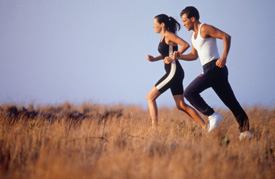
Ligaments Injuries
Ligaments support the joints and prevent joint injuries during normal body functions such as walking, running, lifting, sitting, squatting, jumping, etc. Ligaments have a very tough yet slightly elastic quality about them. They are attached to the bone that is in and about the joint proper.
Some ligaments do not play a roll in joint support but do provide a high degree of support to other body tissues such as the round ligament which supports the female reproductive organs.
The major difference between ligament and bone comes down to the arrangement of calcium ions and manganese ions. Both are associated with a phosphate ion. Calcium phosphate forms the crystalline structure of bone and manganese glycerophosphate forms the more pliable ligament structure. Tendons are the ends of a muscles which insert into the bone in and around a joint. Tendons are very dense and inelastic protein structures that cause a joint to move through a certain range of motion as a muscle contracts or relaxes. The toughness of this protein is also influenced by the trace mineral manganese.
Injuries to ligaments usually result in some level of joint damage where tendon injuries do not. Although ligament and tendon injuries can often be surgically reattached, this level of injury is generally associated with some level of long range degenerative change in the joint structure. As a result of ligament or tendon injuries the healing properties of ligaments, tendons and joints must be carefully attended to and chiropractic coupled with nutritional care is a great treatment regimen. Gentle passive joint mobilizations and range of motion exercises should begin as soon as the inflammatory process is controlled. I like ice treatments during the first few days progressing to ice and heat with passive ROM and non-resistive exercises graduating to resistive stretching and exercising. You can review past blogs that address osteoarthritis prevention and treatments at Seaside Wellness Center: Managing Osteoarthritis.

Nutrition
Dietary changes and nutritional therapies that include anti inflammatory foods such as beets, turmeric, and bromelain enzyme containing foods such as defatted almond (nut), fig (fruit) that are high in papain, bromelain, amylase, lipase, and cellulase. Lots of spring water is also a must. The key trace mineral is manganese and the go to foods are whole grains, nuts, leafy vegetables, and teas. Apples which are high in pectin and apple cider vinegar intake also supports healing of sprained ligaments.
Helpful herbals include turmeric for inflammation, celery seed to decrease joint acids, ginger to improve joint circulation, gotu kola to enhance capillary permeation and avoid scare tissue formation and boswellia to help with pain management. I also like to supplement with a ligament support supplement that is high is manganese glycerophosphate and sulfated amino acids such as glucosamine sulfate.
I also always recommend an appropriate aromatherapy that tends to enhance the healing processes. Healing times always varies depending on the health substance of the injured body. It is a simple conclusion that patients who are attentive to their diet and exercise routines simply get better faster. Either way plan on a minimum of six weeks and a maximum of six months depending on the severity of the injury and in surgery was necessary. If you want the fastest healing time yo have to be willing to participate in the healing process at every level.
Dr. John E. Weisberg
